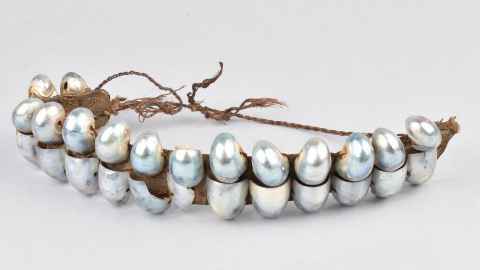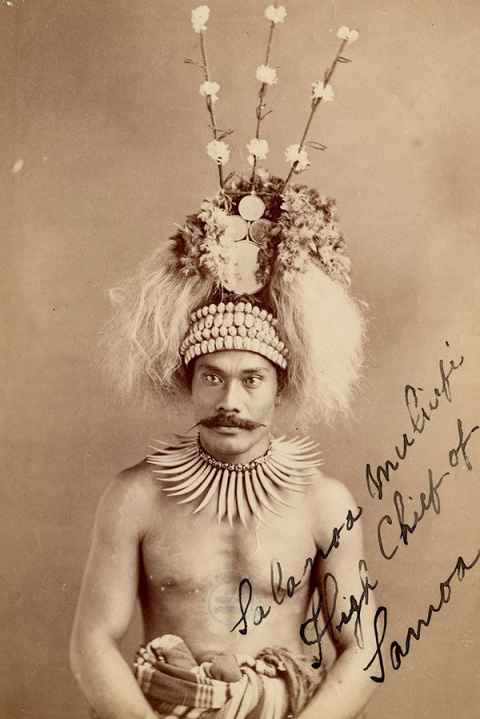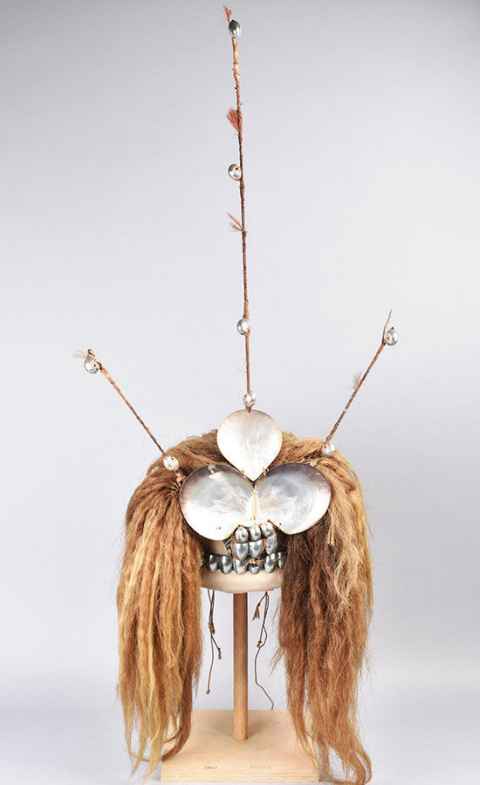Power and plumage: grad's focus on Pacific headdresses
9 September 2025
The significance of chiefly headdresses in Sāmoa, Tonga and Fiji are the focus of art history graduate Talei Tu’inukuafe’s first-of-its-kind doctoral thesis.

Crimson feathers, pearl-like shells, human hair, tapa cloth: these prized materials were all part of one of the most chiefly adornments across the Pacific, the headdress.
Graduating with a PhD in art history in the University of Auckland’s Spring ceremonies, Talei Tu’inukuafe focused on the headdresses worn by chiefs and high-ranking families in Sāmoa, Tonga and Fiji.
Her thesis highlights their significance as expressions of power, lineage, and prestige, and as a previous collection manager for the Auckland Museum’s Pacific collection, she has seen these beautiful, ancient treasures at close hand.
“Adornments like these can’t be understood purely as decorative art,” says Talei. “They were living expressions of chiefly identity and mana (power and authority). They connected their wearers to divine progenitors and were material signifiers of genealogical power.”
Talei’s fascination with the subject began during her masters thesis on the tuiga, a Sāmoan chiefly headdress.
“That project showed me how deeply these headdresses were tied to ideas of divine power, chiefly status, and authority,” she says. “I wanted to expand that lens across the region, to see how these adornments connected and diverged across Polynesia.”
Her PhD, the first of its kind, traces the significance of the tuiga, the Tongan palā tavake, and Fijian i-sala vuti ni manumanu (chiefly headdresses).
She says the red parrot feathers used in such adornments were highly valued; gathered and exchanged through elaborate trade networks, and used to adorn the highest of ceremonial goods that circulated when important alliances and marriages were formed.
“The colour red itself has symbolic importance across the Pacific, often linked to spiritual deities and cosmologies and sacred bloodlines.”

Much of her work involved bringing the indigenous stories behind the adornments and their materials to light; a practice, she says, that is not always done when they are stored away or displayed in museums, separated from their original wearers.
Talei drew on a diverse range of sources, from explorer and missionary accounts to Indigenous Pacific oral histories and knowledge systems, which as a person of Sāmoan (Tufutafoe, Lefagaoaliʻi, Samauga, Safune, Fasitoʻouta), Fijian (Savusavu, Vanua Levu) and Māori (Ngāti Raukawa ki te Tonga Tūhourangi) descent herself, she was keen to highlight.
“I’m a proud Pacific and Māori woman, and I’ve been raised to value each unique part of my heritage, so that’s probably why I became so invested in this research. It resonates deeply with me and connects me to my history and cultural identity.”
Alongside her doctoral study, Talei has built a career in the museum sector, beginning with internships through the Tautai Pacific Arts Trust, later in Europe, and now, at Auckland Museum.
As the current associate curator Māori at the museum, she is an integral part of the Taonga Māori team, responsible for a collection of around 13,000 items.
Her role spans everything from planning what goes on display and hosting research visits to repatriation work and providing access to the collection for iwi, hapū, and whānau.
“The work I do in museums connects strongly with my PhD,” she says. “Both are about recognising the cultural and intellectual authority of Indigenous knowledge and ensuring that treasured objects are not treated as detached or inert, but as part of living communities.”

The path to finishing her thesis came with some challenges.
She started it in 2019 with plans to travel widely, particularly to European museums that house some of the oldest Pacific collections. However, in 2020, she was in the UK on a research residency looking at Māori head adornments in museum collections when the Covid pandemic struck, borders closed, and her travel plans had to be abandoned.
“It was a huge shift,” she says. “I had to drastically narrow my scope to just three case studies from Western Polynesia. At first it was frustrating, but it turned out to be a blessing.
“Fiji, Tonga, and Sāmoa represent a crucial starting point for Polynesian migration which spread eastward from there, so focusing on those islands and the nuances in their adornment practices made sense; it allowed me to delve deeper in my analysis.”
Her studies were also affected by the fact that she had a baby three-quarters of the way through.
“I wouldn’t necessarily recommend doing it in that order, but I’m grateful for the arrival my son. It pushed me to finish my PhD.”

Even though she’s a self-described “history nerd,” she admits she never imagined herself completing a doctorate.
“I’m always curious about why we did things the way we did, how practices evolved, and why some traditions didn’t continue. But I never planned to do a PhD. I’m still amazed I’ve come through and can only thank the Lord for bringing me through it.”
Graduation, on 8 September, will be a proud day, not only for Talei, but for her extended aiga (family), and while her headdress will be fresh flowers, she will also be wearing an array of cultural regalia that hold special significance.
“I see this as a success not only for myself but for my family, my extended whānau and aiga, who prayed for me and really pushed me to complete this task when it seemed impossible. It’s a win for all of us,” she says.
And after giving this celebration its due, she intends to eventually do some postdoctoral research into other forms of chiefly headdress across wider Polynesia.
“These adornments still have many stories left to tell. They’re not just part of the past; they’re part of our cultural birthright and who we are today.”
‘Sacred Power and Chiefly Headdresses in Sāmoa, Tonga and Fiji’ by Talei Tu’inukuafe is available at ResearchSpace. Talei Tu’inukuafe's PhD supervisors were Professor Ngarino Ellis (Ngāpuhi, Ngāti Porou) and Associate Professor Caroline Vercoe (Sāmoa, Aotearoa New Zealand).
Media contact
Julianne Evans | Media adviser
M: 027 562 5868
E: julianne.evans@auckland.ac.nz